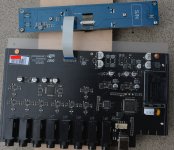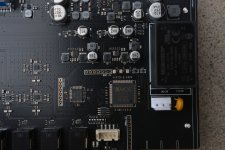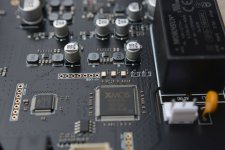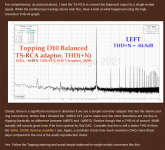Here is the link to the AD1955 for reference.Do you have an example of what is ?
On page 18 is roughly how the D10 balanced IV conversion looks like.
On page 19 there is a simple balanced to single ended converter added after the IV converter. I would guess that this is how most companies would do it.
Schematic details will vary for sure
Thanks but I have been aware of AD1955 datasheet and what it contains for a little while now and it is not, according to you, a high-end solution. What is?
Sorry I misunderstood your question.
First, there is nothing terribly wrong with the implementation.
The balanced to single ended conversion has one fundamental issue and this is noise. Douglas Self devoted several pages in his book "small signal audio design" on low noise balanced to single ended conversion. This is an inherent problem caused by the resistor noise in the circuitry mostly. The solution is to parallel a huge number of amplifiers (buffers and differential amplifiers) in order to lower the noise and to lower the resistors as far as possible. For a low noise conversion you would need four dual op-amps. Also, the resistors need to have low tolerance (0.1%) for good PSRR. Overall, a pretty expensive and bulky solution.
Lowering the resistors around the differential amplifiers leads to another problem: The op-amp will be forced into class AB operation for higher signal amplitude. While class AB operation is a trade off to be made for power amplifiers, it is a terrible idea for small signal circuitry in my opinion. Vast amounts of negative feedback will lower inherent crossover distortion, but it would be better to run small signal stages in class A entirely. I have no idea how to solve this issue in an elegant way.
Buffers are not needed in the application inside the DAC we are discussing here. They are mainly needed to achieve good PSRR of the differential amplifier by negating unknown and unequal source impedance of the inverting and non-inverting signal received.
So this is the issue with balanced to single ended conversion. Putting this right there where the balanced signals are generated (here, the DAC) is a bad idea because the opportunity to use more sophisticated conversion is missed and after the conversion the inherent issues with single ended signal transmission need to be dealt with, which are difficult to overcome. Worst of all options.
So the best idea is really to have a DAC with balanced output and benefit from noise immunity of the balanced signal transmission and do the conversion to single ended in the receiving device. It needs to be done somewhere in any case - why not do it where the benefit outweighs the problems? Here, one can either implement a simple solution like a buffered differential amplifier (requiring two dual op-amps) or a more sophisticated like Self proposes (four or maybe even eight dual op-amps) or use some THAT amplifier IC or transformers.
The reason why the balanced output can be abused as single ended is that the output of the DAC IC is two out of phase signals that each do have a reference to ground. By doing so, 6dB headroom is lost and single ended ground related issues may occur.
First, there is nothing terribly wrong with the implementation.
The balanced to single ended conversion has one fundamental issue and this is noise. Douglas Self devoted several pages in his book "small signal audio design" on low noise balanced to single ended conversion. This is an inherent problem caused by the resistor noise in the circuitry mostly. The solution is to parallel a huge number of amplifiers (buffers and differential amplifiers) in order to lower the noise and to lower the resistors as far as possible. For a low noise conversion you would need four dual op-amps. Also, the resistors need to have low tolerance (0.1%) for good PSRR. Overall, a pretty expensive and bulky solution.
Lowering the resistors around the differential amplifiers leads to another problem: The op-amp will be forced into class AB operation for higher signal amplitude. While class AB operation is a trade off to be made for power amplifiers, it is a terrible idea for small signal circuitry in my opinion. Vast amounts of negative feedback will lower inherent crossover distortion, but it would be better to run small signal stages in class A entirely. I have no idea how to solve this issue in an elegant way.
Buffers are not needed in the application inside the DAC we are discussing here. They are mainly needed to achieve good PSRR of the differential amplifier by negating unknown and unequal source impedance of the inverting and non-inverting signal received.
So this is the issue with balanced to single ended conversion. Putting this right there where the balanced signals are generated (here, the DAC) is a bad idea because the opportunity to use more sophisticated conversion is missed and after the conversion the inherent issues with single ended signal transmission need to be dealt with, which are difficult to overcome. Worst of all options.
So the best idea is really to have a DAC with balanced output and benefit from noise immunity of the balanced signal transmission and do the conversion to single ended in the receiving device. It needs to be done somewhere in any case - why not do it where the benefit outweighs the problems? Here, one can either implement a simple solution like a buffered differential amplifier (requiring two dual op-amps) or a more sophisticated like Self proposes (four or maybe even eight dual op-amps) or use some THAT amplifier IC or transformers.
The reason why the balanced output can be abused as single ended is that the output of the DAC IC is two out of phase signals that each do have a reference to ground. By doing so, 6dB headroom is lost and single ended ground related issues may occur.
Assuming you want to roll your own solution there are some useful tips on using THAT 12xx series balanced line receivers in this article:
https://audioxpress.com/article/getting-the-most-from-that-s-balanced-line-drivers-and-receivers
Douglas Self has a nice review of how to use multiples of the 5532 in various ways to achieve a very low noise balanced receiver, but I think the THAT solution is much easier to use by a DIYer. There are even off-the shelf boards like this one:
https://www.sparkfun.com/products/14002
One advantage of using balanced interconnects is that you can locate the DAC near the computer and put the amps near the loudspeakers so that the speaker wires are short. The balanced line hum and noise rejection allows you to increase the flexibility of placement for these components, which is a plus in my book.
https://audioxpress.com/article/getting-the-most-from-that-s-balanced-line-drivers-and-receivers
Douglas Self has a nice review of how to use multiples of the 5532 in various ways to achieve a very low noise balanced receiver, but I think the THAT solution is much easier to use by a DIYer. There are even off-the shelf boards like this one:
https://www.sparkfun.com/products/14002
One advantage of using balanced interconnects is that you can locate the DAC near the computer and put the amps near the loudspeakers so that the speaker wires are short. The balanced line hum and noise rejection allows you to increase the flexibility of placement for these components, which is a plus in my book.
I, for one, am excited when there are more products and competition for multichannel D/A converters.
I, too, use mini-PCs, due to general flexibility. Sometimes I steer towards Mac or Linux but the Lane Departure Alert (lack of software of my favourite tools) steers me back to Windoze
I, too, use mini-PCs, due to general flexibility. Sometimes I steer towards Mac or Linux but the Lane Departure Alert (lack of software of my favourite tools) steers me back to Windoze
Here is an actual built of Douglas Self's low noise receiver: http://mnats.net/self_balanced_input.html
Hi, photos of pcb attached ... if any one interested 🙂
my plan is to use it as car audio DSP (together with RPI/CamillaDSP).
good thing is that it's powered from 5V DC (MORNSUN AC/DC converter) so it might be easy to implement it;
but i need more channels. what do you think about sourcing external mclk (to chain two or more boards together with common MCLK)? but those crystals are so small - wayyy over my soldering skills 🙂
my plan is to use it as car audio DSP (together with RPI/CamillaDSP).
good thing is that it's powered from 5V DC (MORNSUN AC/DC converter) so it might be easy to implement it;
but i need more channels. what do you think about sourcing external mclk (to chain two or more boards together with common MCLK)? but those crystals are so small - wayyy over my soldering skills 🙂
Attachments
That looks like the TRS-RCA adaptor is grounding one output. I don't see how both outputs of the Topping have that harmonic spew and it being 'cancelled' downstream by the destination device.doesn't do well single ended.
That's exactly what does happen though. The outputs of modern DACs are inherently balanced and have particularly terrible performance when you analyse only one half of the output. The actual performance of the device comes when you sum the differential output and the DACs non linearities cancel out.That looks like the TRS-RCA adaptor is grounding one output. I don't see how both outputs of the Topping have that harmonic spew and it being 'cancelled' downstream by the destination device.
Without this summing the performance is terrible.
The output of this Topping DAC is fully balanced and has no single ended output. You will only get the performance it's capable of if you use a balanced device after it. One of those differential to single ended cables will not work and grounding the output of the cold side has nothing to do with it. If you use only the hot you'll get terrible performance. You need a balanced to single ended line receiver in that case.
Basically it's as Charlie says. If you don't have amplifiers with balanced inputs then buy another DAC. Or build an active 8 channel diff to SE converter.
my plan is to use it as car audio DSP (together with RPI/CamillaDSP).
@mahtew:
Have you tested it under Linux to make sure it works, all channels operate at the advertised rates and bit depths, etc? It's a pretty new product and you never know if a driver has been loaded into the current kernel or whether you have to wait until that happens.
Let us know about your experience with it. It's an interesting product and sort of like a much better performing MiniDSP U-DAC8 (which is now discontinued but was kind of 'meh').
Have you tested it under Linux to make sure it works, all channels operate at the advertised rates and bit depths, etc? It's a pretty new product and you never know if a driver has been loaded into the current kernel or whether you have to wait until that happens.
Let us know about your experience with it. It's an interesting product and sort of like a much better performing MiniDSP U-DAC8 (which is now discontinued but was kind of 'meh').
not yet. will do that in a week or so. but if i remember correctly someone already tested DM7 with linux and it worked OK (on audioscience DM7 thread). also plan to test it with CosmosADC... but need to wait for TRS jacks 🙂
That runs counter to decades of making these cables for professional environments. And yes, using APs since the 1980s to confirm performance. You might be confusing this with external noise rejection and CMRR. Consider the typical budget balanced output: a dual opamp with the positive phase driving one balanced output and also feeding a second inverting input to generate the mirror phase. Where is all this distortion on both phases originating? In the opamps? Upstream? Are all distortion harmonics, both even and odd, antiphase for cancellation?Without this summing the performance is terrible.
In the most common scenarios a balanced to unbalanced output interconnect should always leave one balanced phase floating and only connect the other to the RCA hot pin, with the RCA ground sleeve returning to source ground. Otherwise you're presenting a zero ohm load to half the chip. I don't play with dead bugs so don't know how a typical dual reacts to dead shorts but don't see a benefit.
Potential exceptions are active instrumentation and transformer coupled outputs.
Yes but this is not how these DACs work. There are shared, common mode, non linearities on each half of the DACs balanced outputs. They need to be summed correctly for you to get the specified performance.
Topping have designed this to fit a price bracket so have only provided the bare minimum for specified performance when using the balanced outputs. A more expensive product would have summing amplifiers inside and SE outputs too.
Topping have designed this to fit a price bracket so have only provided the bare minimum for specified performance when using the balanced outputs. A more expensive product would have summing amplifiers inside and SE outputs too.
kazap's result represents a ~50dB degradation against specified THD for the D10B's ES9038Q2M chip. Would that be normal expectation? Nearest I could find is an ASR forum contribution of a Genelec internal DAC measurement using the same chip in voltage mode showing roughly the same low harmonic levels without all the higher harmonics.
https://www.audiosciencereview.com/...urements-of-generic-es9038q2m-dac-board.2408/
FWIW, archimago did the measurements with an incorrect tip-ring shorting adapter below, which look much closer to kazap's.
http://archimago.blogspot.com/2021/08/measurements-topping-d10-balanced-d10b.html
https://www.audiosciencereview.com/...urements-of-generic-es9038q2m-dac-board.2408/
FWIW, archimago did the measurements with an incorrect tip-ring shorting adapter below, which look much closer to kazap's.
http://archimago.blogspot.com/2021/08/measurements-topping-d10-balanced-d10b.html
Attachments
That looks like the TRS-RCA adaptor is grounding one output.
Yes. It was a grab off the net but Im sure you are right that the TRS-RCA adaptor used with that measurement of a different DAC actually shorted out half the output stage! Apologies for posting that off topic misleading measurement.
None required! It was a learning experience all around, including for me contemporary DAC topology. The behaviour in your measurements still represents a design flaw IMO.Apologies for posting that off topic misleading measurement.
I wonder if the same reasoning hold true for a BTL class D output, or any BTL output?Yes but this is not how these DACs work. There are shared, common mode, non linearities on each half of the DACs balanced outputs. They need to be summed correctly for you to get the specified performance.
Only read this today and I chuckled 🙂 Still I prefer RCA, never got around using balanced except converting it in DACs to unbalanced. My wish is for an all in one audio player with balanced DACs to internal balanced volume control and internal balanced class D amplifiers (so no balanced cabling with XLR plugs).RCA is the pineapple pizza of audio.
Never ordered a pineapple pizza either I think but maybe they are delicious.
Last edited:
- Status
- Not open for further replies.
- Home
- Source & Line
- PC Based
- Topping DM7 8-channel USB DAC using ESS ES9038PRO - wow!



